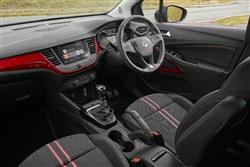CROSS WITH MORE PURPOSE (some text hidden) --NONE--
By Jonathan Crouch
Introductionword count: 79
By 2020, Vauxhall had decided it needed not one but two small SUVs in its product portfolio, this little Crossland model sitting just below the second generation Mokka crossover in the company's crossover line-up. This Crossland was a facelift of the car we had first seen back in 2017 badged as the 'Crossland X'. In 2020, this model lost the 'X' in its name and received more engaging front-end styling that aimed to give it a more up-to-the-minute feel.
Modelsword count: 7
5dr SUV (1.2 Turbo, 1.5 Turbo D)
Historyword count: 329
Small SUVs are where the market's at these days - and by 2020 Vauxhall had two. The most affordable was their Crossland model, first launched in 2017 but usefully upgraded three years and 300,000 sales on to create the car we're going to look at here. Back in 2017 when Vauxhall small SUVs were 'X'-designated, the original version of this car, the Peugeot/Citroen-derived Crossland X, arrived to share showroom space - and much the same customer base - with the Griffin brand's older Korean-built Mokka X crossover. By the beginning of this century's third decade, both models had lost their 'X' designations and it was the other way around in Vauxhall dealerships. The Mokka (which by now also had Peugeot/Citroen engineering) was the newcomer and by 2020, the Crossland SUV was starting to show its age, hence a package of facelift updates which created the car we look at here. With sparkly new Mokka models in the showrooms, it was easy to wonder back in 2020 why Vauxhall really still needed this car. It did - and the brand was far from being alone in this period in offering a pair of very compact Crossover contenders in this segment. At this time, Fiat, Ford, Honda and Toyota were all also taking much the same approach - which worked fine providing the two products in question were fundamentally different, as was certainly the case here. The Crossland continued with the old PF1 platform used for older PSA Group small cars - unlike the Mokka which had got the conglomerate's newer CMP underpinnings. That was the reason why Crossland folk weren't offered any kind of engine electrification - or the kind of full-battery-powered option they could have in a comparable Corsa supermini. Still, continuing on with proven mechanicals allowed the brand to keep Crossland pricing tight, which was something that mattered much more to likely customers. The Crossland sold in this form until it was replaced by the Frontera in late-2024.
What You Getword count: 517
Buyers in the smallest SUV segment tend to prioritise aesthetics more than those in larger Crossover categories, so with that in mind, it was important for Vauxhall to give this Crossland a more contemporary look and feel - which the brand was able to do here as part of the roll-out of its latest design language, showcased at the front. The nose got a so-called 'Vauxhall Vizor' front panel, a single module which runs across the face of the car containing LED headlights and the updated version of the marque's Griffin badge. In profile, the updates over the original Crossland are herder to spot - a chrome strip at the top of the lower door sill mouldings and a range of redesigned 16 and 17-inch wheels; that's about it. Move to the rear and the SUV design cues continue, clouding the reality that the Crossland doesn't actually sit much further off the ground than a typical family hatch. The high-mounted split rear lights, which smear round into the C-pillars to help with that floating roof illusion, gain dark tinting. Up front at the wheel, if you switch to a Crossland from, say, the kind of Corsa supermini model that flowed down the same Spanish Zaragoza production line, there's hardly any acclimatisation required at all: you don't even sit much higher. As for cabin updates made to this Crossland over the old Crossland X, well there aren't really any, though Vauxhall made a more supportive AGR-certified front seat more widely available and, as before, with sporty 'SRi' trim, you get stripy upholstery and brightly coloured door and fascia inserts to try and lift the ambiance a bit. Otherwise, this is an accurate snapshot of where the design of small SUVs was back in 2017, with a relatively small 7 or 8-inch centre-dash infotainment screen and an even more diminutive 3.5-inch one between the two clear but determinedly analogue instrument binnacle dials The rear is accessed through wide-opening doors. In its original form, the Crossland used to feel slightly bigger in the back than some of its key segment rivals - the old Nissan Juke for instance. It certainly felt more spacious than the old Mokka X. By 2020 though, both those cars had caught up, but the Crossland retained an advantage over both (and quite a few other small SUVs) with its provision of a sliding rear bench. We have to point out that the most affordable 'SE' spec Crossland variants didn't get this feature but if you can stretch to a spec level providing this item, you'll be able to prioritise either load or leg space by pushing the base either backwards or forwards over a range of up to 150-millimetres. Finally, let's consider the boot, which is accessed through a decently-sized rectangular aperture and is still one of the larger cargo bays in the class. On a model with the sliding rear seat, it's 410-litres in size with the bench pushed right back - or 520-litres with it pushed right forward. Push forward the backrest and up to 1,255-litres of fairly flat space is opened up.
To see the full road test text contact us on 0330 0020 227
Pictures (high res disabled)

.jpg)
|
.jpg)
|
.jpg)
| |||
.jpg)
|
.jpg)
|
.jpg)
| |||
.jpg)
|
.jpg)
|
.jpg)
| |||
.jpg)
|
.jpg)
|

|
Scoring (subset of scores)
Category: Crossover or SUV 4x4s
| Performance | |
| Handling | |
| Comfort | |
| Space | |
| Styling, Build, Value, Equipment, Depreciation, Handling, Insurance and Total scores are available with our full data feed. | |



